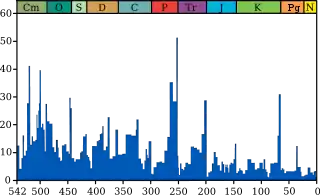End-Botomian mass extinction
The end-Botomian mass extinction event, also known as the late early Cambrian extinctions, refer to two extinction intervals that occurred during Stages 4 and 5 of the Cambrian Period, approximately 513 to 509 million years ago. Estimates for the decline in global diversity over these events range from 50% of marine genera[1] up to 80%.[2] Among the organisms affected by this event were the small shelly fossils, archaeocyathids (an extinct group of sponges), trilobites, brachiopods, hyoliths, and mollusks.[1][3][4][5]
Causes
There are several hypotheses for the causes of these extinctions. There is evidence that major changes in the carbon cycle[6][7][8][9] and sea level occurred during this time.[1][10] Evidence also exists for the development of anoxia (a loss of oxygen) in some environments in the oceans.[1][11][12]
One hypothesis that unifies this evidence links these environmental changes to widespread volcanic eruptions caused by the emplacement of the Kalkarindji Large Igneous Province or LIP.[13][14] These widespread eruptions would have injected large amounts of greenhouse gases into the atmosphere causing warming of the climate and subsequent acidification and loss of oxygen in the oceans.[13] However the precise timing between the eruptions and the extinction events remain unresolved.[14]
References
- Zhuravlev, Andrey Yu.; Wood, Rachel A. (1996). "Anoxia as the cause of the mid-Early Cambrian (Botomian) extinction event". Geology. 24 (4): 311. doi:10.1130/0091-7613(1996)024<0311:aatcot>2.3.co;2. ISSN 0091-7613.
- Signor, Philip W. (1992). "Taxonomic diversity and faunal turnover in the Early Cambrian: Did the most severe mass extinction of the Phanerozoic occur in the Botomian stage?". The Paleontological Society Special Publications. 6: 272. doi:10.1017/S2475262200008327. ISSN 2475-2622.
- Zhuravlev, Andrey Yu. (1996). "Reef ecosytem recovery after the Early Cambrian extinction". Geological Society, London, Special Publications. 102 (1): 79–96. doi:10.1144/GSL.SP.1996.001.01.06. ISSN 0305-8719.
- Porter, S.M. (May 2004). "Halkieriids in Middle Cambrian Phosphatic Limestones from Australia". Journal of Paleontology. 78 (3): 574–590. CiteSeerX 10.1.1.573.6134. doi:10.1666/0022-3360(2004)078<0574:HIMCPL>2.0.CO;2. Retrieved 2008-08-01.
- Debrenne, Françoise (1991). "Extinction of the Archaeocyatha". Historical Biology. 5 (2–4): 95–106. doi:10.1080/10292389109380393. ISSN 0891-2963.
- Brasier, M. D.; Corfield, R. M.; Derry, L. A.; Rozanov, A. Yu.; Zhuravlev, A. Yu. (1994). "Multiple δ13C excursions spanning the Cambrian explosion to the Botomian crisis in Siberia". Geology. 22 (5): 455. doi:10.1130/0091-7613(1994)022<0455:mcestc>2.3.co;2. ISSN 0091-7613.
- Brasier, M D; Sukhov, S S (1998). "The falling amplitude of carbon isotopic oscillations through the Lower to Middle Cambrian: northern Siberia data". Canadian Journal of Earth Sciences. 35 (4): 353–373. doi:10.1139/e97-122. ISSN 0008-4077.
- Faggetter, Luke E.; Wignall, Paul B.; Pruss, Sara B.; Newton, Robert J.; Sun, Yadong; Crowley, Stephen F. (2017). "Trilobite extinctions, facies changes and the ROECE carbon isotope excursion at the Cambrian Series 2–3 boundary, Great Basin, western USA" (PDF). Palaeogeography, Palaeoclimatology, Palaeoecology. 478: 53–66. doi:10.1016/j.palaeo.2017.04.009.
- Zhu, Mao-Yan; Zhang, Jun-Ming; Li, Guo-Xiang; Yang, Ai-Hua (2004). "Evolution of C isotopes in the Cambrian of China: implications for Cambrian subdivision and trilobite mass extinctions". Geobios. 37 (2): 287–301. doi:10.1016/j.geobios.2003.06.001.
- Hallam, A (1999). "Mass extinctions and sea-level changes". Earth-Science Reviews. 48 (4): 217–250. doi:10.1016/S0012-8252(99)00055-0.
- Hough, M.L.; Shields, G.A.; Evins, L.Z.; Strauss, H.; Henderson, R.A.; Mackenzie, S. (2006). "A major sulphur isotope event at c . 510 Ma: a possible anoxia-extinction-volcanism connection during the Early-Middle Cambrian transition?: Global warming as a major determining factor in biosphere evolution". Terra Nova. 18 (4): 257–263. doi:10.1111/j.1365-3121.2006.00687.x.
- Pagès, Anais; Schmid, Susanne; Edwards, Dianne; Barnes, Stephen; He, Nannan; Grice, Kliti (2016). "A molecular and isotopic study of palaeoenvironmental conditions through the middle Cambrian in the Georgina Basin, central Australia". Earth and Planetary Science Letters. 447: 21–32. doi:10.1016/j.epsl.2016.04.032.
- Evins, Lena Z.; Jourdan, Fred; Phillips, David (2009). "The Cambrian Kalkarindji Large Igneous Province: Extent and characteristics based on new 40Ar/39Ar and geochemical data". Lithos. 110 (1–4): 294–304. doi:10.1016/j.lithos.2009.01.014. hdl:20.500.11937/35356.
- Glass, Linda M; Phillips, David (2006). "The Kalkarindji continental flood basalt province: A new Cambrian large igneous province in Australia with possible links to faunal extinctions". Geology. 34 (6): 461. doi:10.1130/G22122.1. ISSN 0091-7613.
